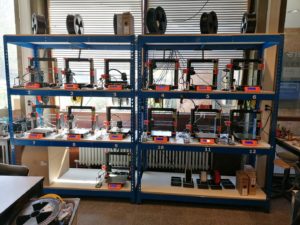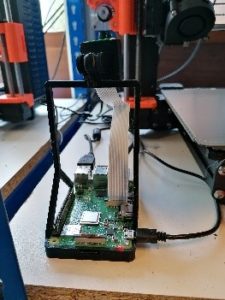FabLab increases production capacity with 3D Printing Farm
 Since February 2021 a 3D printing farm has been installed in FabLab. A whát, you might think.
Since February 2021 a 3D printing farm has been installed in FabLab. A whát, you might think.
The concept ‘farm’ may not immediately remind you of a fine piece of technology. Yet, this is exactly what it is. In a 3D printing farm the focus is on the optimal implementation of the printers’ capacity, in other words: striving for a maximization of the output and this by using software that can manage the printers.
The manager of the FabLab, Marc Lambaerts, was inspired by the Czech company Prusa, one of the leading companies specialized in 3D printing. Currently, Prusa has more than 1000 printers operational according to the principle of the 3D printing farm. Marc contacted Flanders Make, that provided him with the tools to be able to develop such a farm. These tools came in the form of free software, being two apps, named RaiseCloud and Octoprint. This combination makes it possible to manage printers from a distance. Through the apps the employees of FabLab get access to the printing farm and can clearly see which printers are active, in stand-bye, show an error code, …
 Through the apps you get a live overview of the different printers and the projects that are being printed at that very moment. A camera, which is installed on the Raspberry Pi of the printer, always makes sure that there can be a live connection with the printer in case visual control is needed. As a last feature Lowie Goossens wrote a plug-in for Octoprint which ensures a label is being printed once the print has finished – the label mentions the print’s name. This way all steps in the process are easy to follow.
Through the apps you get a live overview of the different printers and the projects that are being printed at that very moment. A camera, which is installed on the Raspberry Pi of the printer, always makes sure that there can be a live connection with the printer in case visual control is needed. As a last feature Lowie Goossens wrote a plug-in for Octoprint which ensures a label is being printed once the print has finished – the label mentions the print’s name. This way all steps in the process are easy to follow.
There are numerous advantages of a 3D printing farm. First, such a farm can be managed from a distance; the employees of FabLab Leuven do not need to be present in the lab itself. The printers can also run during nights and weekends, which is a huge advantage – certainly for bigger projects – and leads to extra output.
The extra capacity that can be realized is also an important advantage and is being improved by the fact that the print now only needs to be labeled and taken off the print plate. This takes approximately one minute whereas in the past it took around 15 minutes per print. Therefore, this results in an enormous time gain. Also the risk of mistakes is limited, as the labels are automatically printed once the project has finished.
Since last February FabLab Leuven has realized about 1300 prints through this set-up. In pre-farm era this number could only have been around 300!
The velocity with which the projects can be realized, is something that we shouldn’t forget: students can now assume that their project will be finished in about 24 hours, max 48 hours. If you compare this to the 7 days they had to take into account in the past, then it’s clear that the 3D printing farm offers nothing but advantages. Also, the start-up of a project has become more accessible: the student sends the file per mail and the file is being uploaded to the 3D farm. It’s no longer necessary to come to the FabLab with a SD card or flash drive; all you need to start a print is a simple mail.
With this 3D printing farm FabLab Leuven demonstrates that it keeps renewing and strives to be an environment where creativity is a high priority, without overlooking the production capacity.

